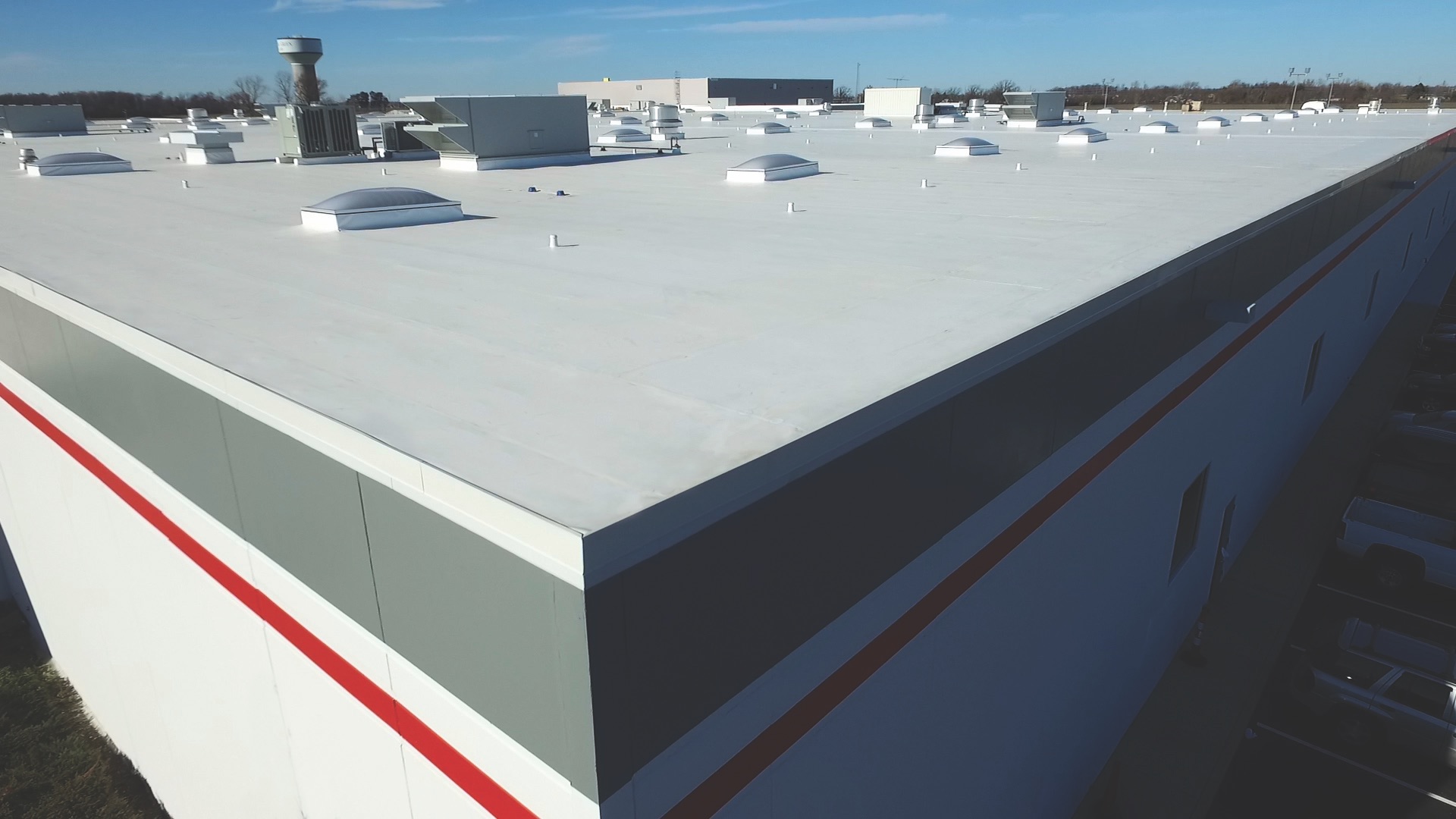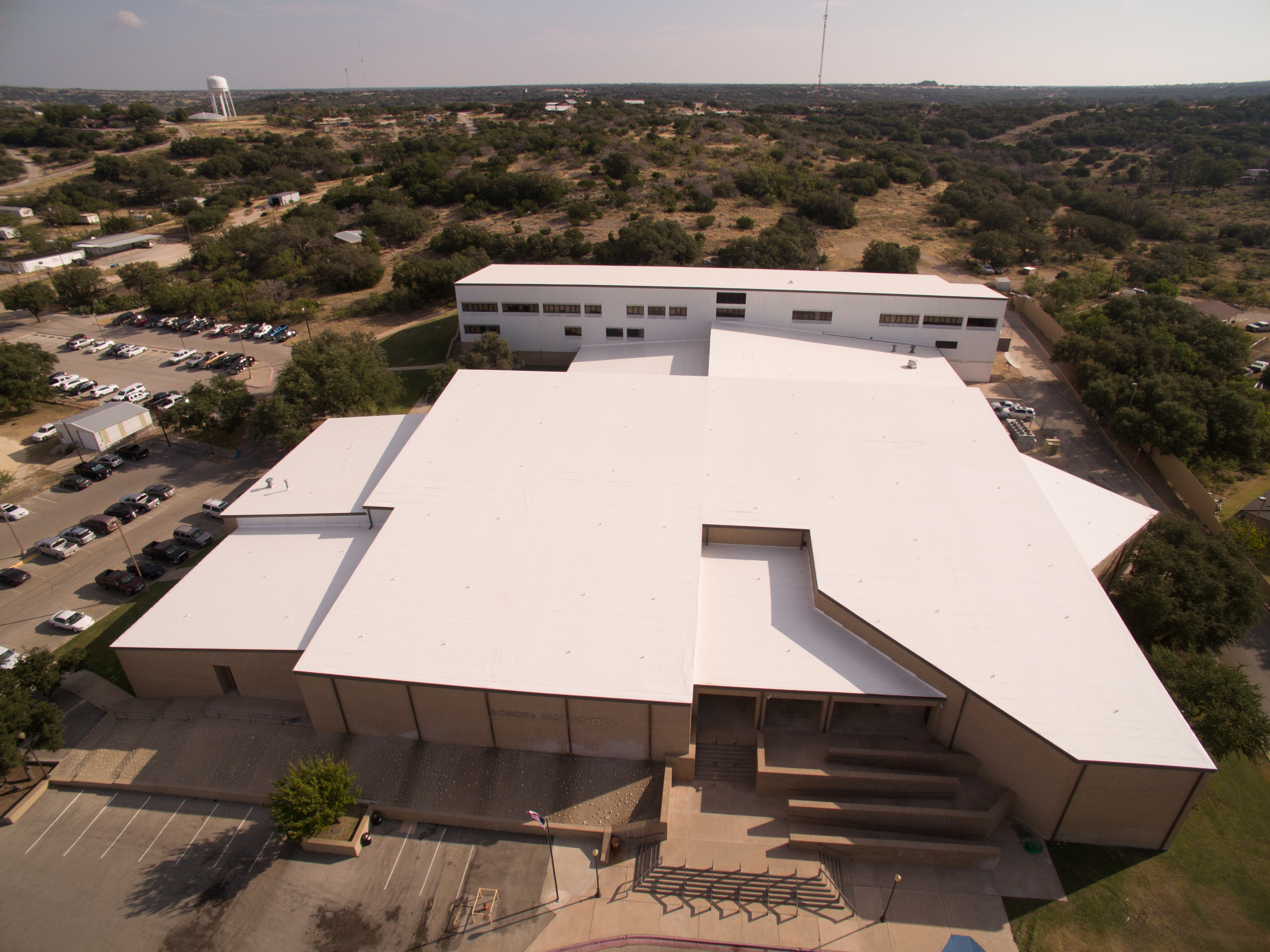Cool Roofs for a Hot Planet
Brief History of Modern Roofing
For many decades, traditional asphalt roofing construction was the norm. Asphalt roofs experience little expansion or contraction, which means there were no thermal shock issues to consider. There was little concern for insulation and heat loss. Air-conditioning use was minimal or was not very costly. Therefore, summer heat retention was of not much concern.
Single-ply membrane products appeared in the early 1970s. Over the past few decades, scientists and product manufacturers developed better knowledge of chemical interactions and have introduced plasticizers and stabilizers into single-ply membranes, which prolong material life. At this point, the single-ply roofing industry has a proven performance record of more than 30 years.
As with any product, the quality of the components affects overall performance.
Types of Membrane Roofing
There are more types of membrane roofing than many architects realize. Modified bitumen, for example, is asphalt-based and blended with styrene-butadiene-styrene or atactic polypropylene. This product is a hybrid of traditional BUR (built-up roofing).
Thermoset membranes are “vulcanized,” which means the molecules are cross-linked, making polymers elastic. However, these materials become “set” so they are difficult to bond to each other. That means they cannot be softened and bonded by heat. Therefore, seaming requires adhesives. These include EDPM, Neoprene, and CSPE (Hypalon).
Thermoplastics will “flow” when heated because the molecules are not cross-linked. That means the seams can be heat welded or solvent welded. Ingredients used in compounding can include PVC resin, plasticizers, stabilizers, pigments, and fillers.
These materials are represented by a somewhat bewildering array of abbreviations: PVC, CPA, EIP, NBP, CPE, PIB, and TPO.
The big players of thermoplastics, however, are TPO (thermoplastic polyolefin) and PVC (polyvinylchloride).
TPOs are relatively new in the field, with most having been installed in the last 20 years. The ASTM standard for TPO is ASTM D 6878-03 for TPO Based Sheet Roofing.

Photo courtesy of Duro-Last, Inc.
PVC membranes can be custom fabricated to fit each roof and penetration.
PVC Membranes
PVC roofing membranes have a much longer history than TPO roofing. PVC’s were introduced in Europe in the early 1960s and a decade later in the United States. PVC roofing systems can be installed on virtually any type of structure in any geographic location. Installations may be on dead flat, low-slope or sloped applications. Of course, it is always good roofing design and installation practice to make sure that water drains properly. However, because vinyl roofing uses no adhesives for seaming and is impervious to water, standing water that frequently occurs on flat roofs will not compromise the integrity of most vinyl systems.
PVC membranes are flexible and lightweight. Because of this, they can be custom-made to fit each roof and can be easily prefabricated. Prefabrication of deck sheets and flashing components entails doing a portion of the manufacturing in a controlled environment; this leads to fewer installation failures.
Additionally, lightweight PVC membranes can be added to an existing roof without any need to modify the roof’s structural system. This means that in many instances tear-off and disposal of the existing roof can be avoided.
Perhaps of most significance, vinyl roofing is continually heat-weldable. It is common knowledge that heat-welded seams are the most reliable, avoiding the potentially weak link of adhesives used in some systems. Being continually heat-weldable allows PVC to be easily repaired and patched.
Heat-seaming completely eliminates adhesive-related seam failure and leaks.
Some PVC roofing systems have two-way venting, which allows the roof system to “breathe” and helps with wind uplift. As an added benefit, this ventilation may help with the release of trapped moisture from the deck and building interior.
Roofs are commonly exposed to such substances as bird droppings, cooking grease, animal fats, furnace residue, incinerator ash, acid rain, and seawater. While these are more common, there is an amazing variety of other less-common substances that can be particularly damaging to some roof systems.
Vinyl membranes are also highly resistant to most chemicals and harsh environments that roofs are subject to. A high level of weatherability means less roof replacements are required over the life of the building.
And, of course, most PVC membranes can be made white in color, which makes them highly reflective and very effective as cool roofing products.

Photo courtesy of Duro-Last, Inc.
There is a long-debunked perception that vinyl is harmful to building occupants. It is not. And its clean installation is considered safer than roofing systems involving tar and hot pots. This vinyl roof was installed on a high school in Sonora, Texas.
Safe for Occupants and the Environment
Despite lingering misperception and long-debunked misinformation, PVC roof systems are indeed safe for building occupants and the environment.
According to Dr. Patrick Moore, a co-founder of Greenpeace: “…PVC’s effects on health and the environment have been investigated at every stage from manufacture through use and on to final disposal. In all cases, vinyl has been shown to be safe and environmentally sound." For example, PVC is the primary material used in medical equipment such as intravenous lines, blood bags and many others.
Consider the sustainable assets. During installation, no danger exists from flames, kettles, or hazardous fumes that could cause disruptions to business or result in irritation to building occupants. This is especially impactful for roofing and re-roofing projects at schools, daycare centers, hospitals, nursing homes, or other buildings occupied by young, old, or sick people.
Vinyl has been subject to more study and research than any other plastic material. PVC is produced in closed-loop manufacturing processes that are tightly monitored and controlled by the Occupational Safety & Heath Administration (OSHA), the Environmental Protection Agency (EPA), and other regulatory bodies.
Vinyl is actually used in a variety of ways to help protect the environment, such as with landfill and livestock waste-pit liners, and chemical containers.
The list of entities affirming PVC safety includes U.S. Centers for Disease Control, Lawrence Berkeley National Laboratory, U.S. Department of Health & Human Services, U.S. Food and Drug Administration, U.S. National Academy of Sciences, and the U.S. Consumer Production Safety Commission.
Installation Considerations
Perhaps one of the reasons PVC thermoplastic single-plies have grown so much is because of their versatility. There are several methods that vinyl roofing systems can be attached.
Mechanically fastened systems offer straightforward, proven methods for meeting codes and look good. A key characteristic is that the installation process for mechanically fastened systems is not sensitive to jobsite conditions such as too hot, too cold, too damp, etc. This means they can be installed virtually any time of the year as long as the contractor is willing to work. As we know, there are contractors in places like Chicago, Illinois; Minneapolis, Minnesota; or Colorado who simply shovel the snow off the roof and go right on working in December, January and February. This method allows that, and could make a difference in your project meeting or missing deadlines important to the owner. Another benefit of mechanically fastened roof systems is that the membrane can be recycled.
Many specifiers choose adhered systems, as they can be aesthetically pleasing. Some drawbacks to adhered systems include installation restrictions due to weather conditions and the inability to recycle the roof membrane after its useful life due to the glues used during installation.









